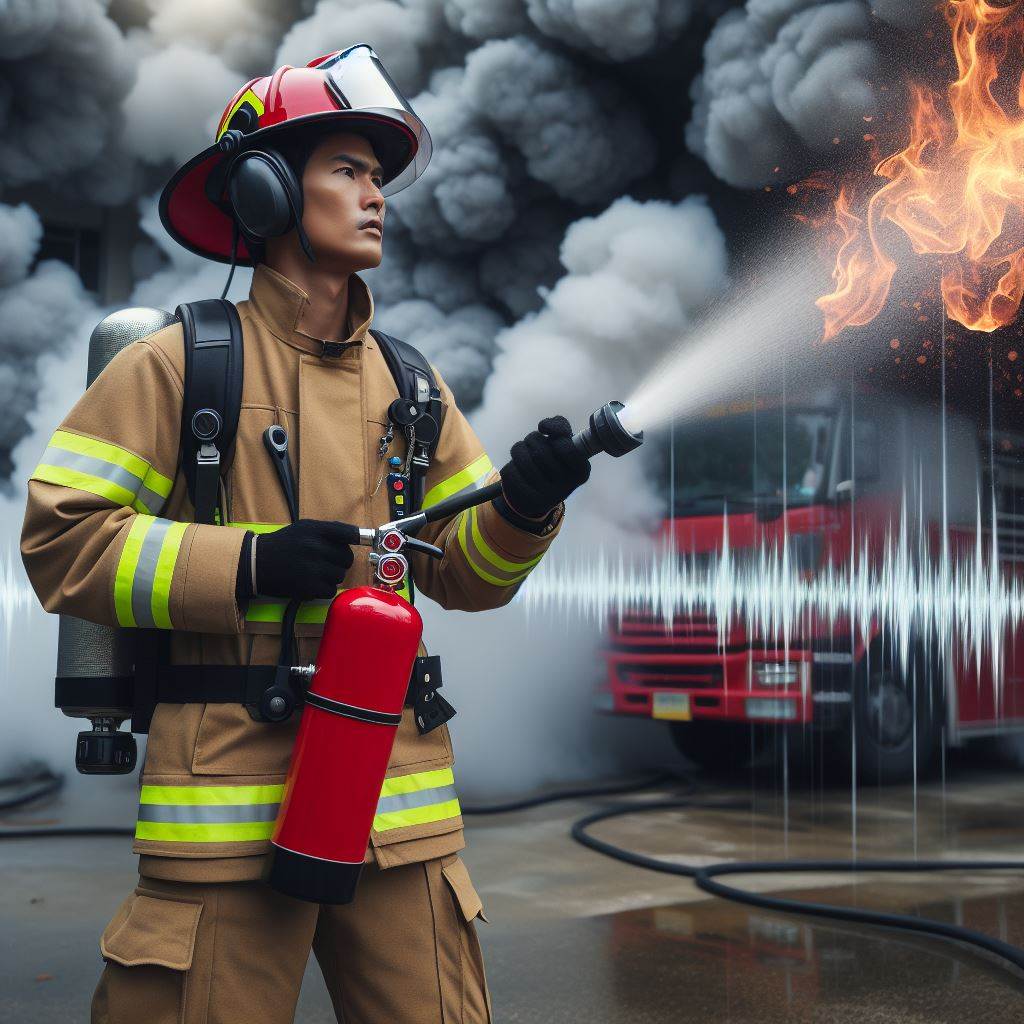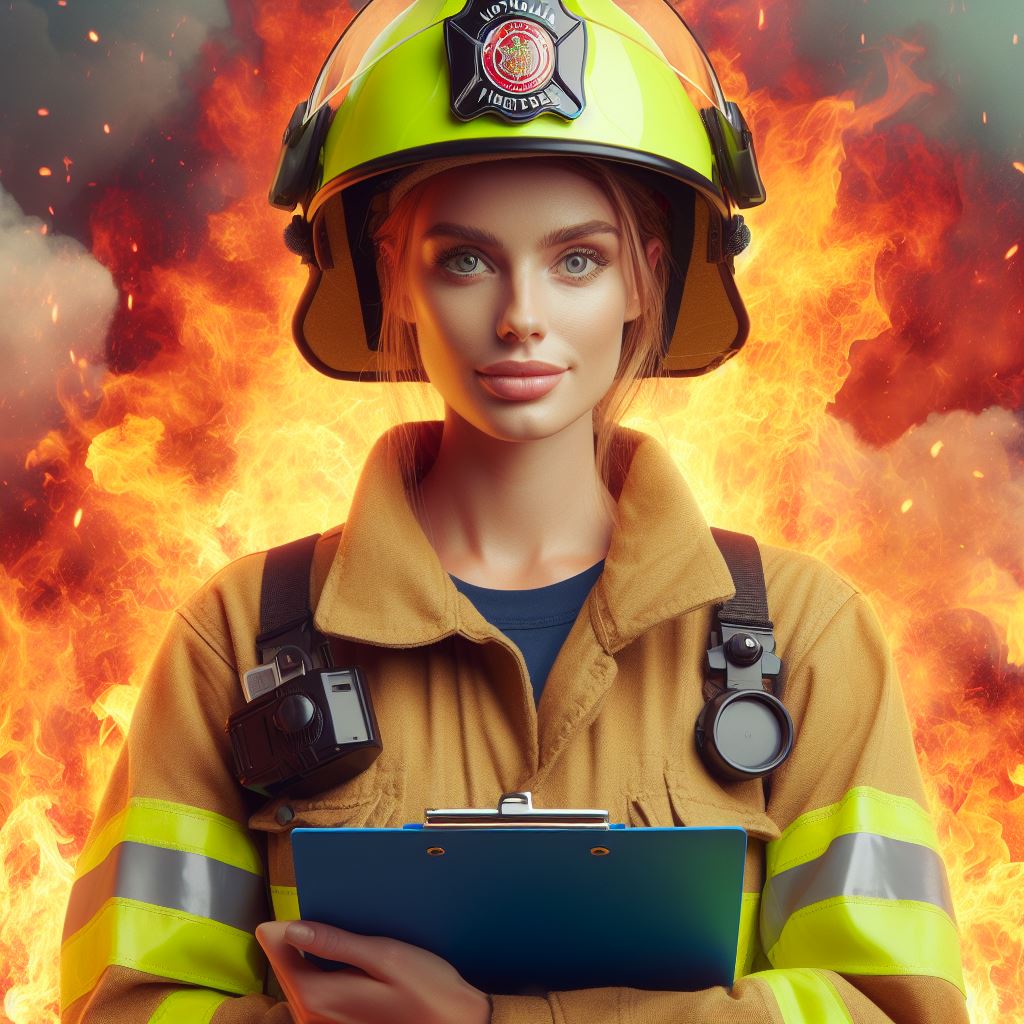Introduction
Firefighting equipment is crucial for the safety and effectiveness of firefighters in controlling and extinguishing fires. The continuous advancements in firefighting technology have revolutionized the way emergencies are handled.
Firefighters are often faced with unpredictable and dangerous situations, where having the right equipment is essential. Firefighting equipment includes tools such as firefighting suits, helmets, gloves, air masks, and self-contained breathing apparatus (SCBA).
These protective gears provide firefighters with the necessary safeguards against intense heat, toxic gases, and falling debris.
In recent years, there have been remarkable advancements in firefighting equipment. For instance, the development of lightweight, heat-resistant materials has significantly enhanced firefighter mobility and endurance.
This allows them to efficiently navigate through confined spaces and inaccessible areas inside burning buildings.
Moreover, technological innovations have led to the creation of more efficient and versatile firefighting tools. One such example is the introduction of thermal imaging cameras, which enable firefighters to locate hotspots and victims hidden by smoke.
This technology minimizes the risks and improves the efficiency of search and rescue operations. Additionally, advancements in fire suppression methods have led to the development of more effective extinguishing agents.
Innovations like compressed air foam systems (CAFS) and high-pressure water mist systems provide firefighters with greater control over fires, reducing the risk of re-ignition and minimizing damage to property.
In review, the significance of firefighting equipment cannot be overstated. Continuous advancements in firefighting technology have revolutionized the field, improving the safety and efficiency of firefighters in their critical mission to save lives and protect property.
These innovations play a pivotal role in enhancing firefighting capabilities and ensuring the well-being of both responders and the community.
Overview of traditional firefighting equipment
Commonly used tools
Firefighters have been relying on traditional equipment for many years to combat fires. These tools, such as fire extinguishers, hoses, and hydrants, have been widely used in various fire rescue operations.
- Fire extinguishers are one of the most commonly used tools in firefighting. These portable devices contain fire suppressants and can quickly extinguish small fires. They come in different types, including water, foam, CO2, and dry chemical extinguishers, each designed for specific fire hazards.
- Hoses are another essential firefighting tool. These flexible tubes are connected to hydrants or water sources and allow firefighters to direct a steady flow of water onto a fire. They come in various lengths and diameters, providing flexibility and adaptability in extinguishing fires.
- Fire hydrants play a crucial role as a water source for firefighters. Typically located along streets or in designated areas, hydrants supply water for hoses. They are connected to the municipal water supply, providing a continuous flow of water in firefighting operations.
Limitations and challenges faced with traditional equipment
While traditional firefighting equipment has proven to be effective, they also have limitations.
- Fire extinguishers, for instance, can only be used for small-scale fires. They have limited extinguishing capacity and may not be suitable for large or spreading fires.
- Similarly, hoses have their own set of challenges. The length of hoses limits the proximity of firefighters to the fire. Additionally, the water pressure might vary, affecting the efficiency of firefighting operations.
- Furthermore, fire hydrants may not always be accessible during emergencies. In some cases, they may be damaged, non-functional, or situated far from the fire incident. This can significantly delay the firefighting process and increase the risk of the fire spreading.
Innovative firefighting equipment developed to overcome the limitations and challenges
To overcome these limitations and challenges, innovative firefighting equipment has been developed. These advancements aim to enhance firefighter safety and improve firefighting efficiency.
- One significant innovation is the introduction of advanced fire extinguishing agents. These agents, such as clean agents and compressed air foam, have superior extinguishing capabilities compared to traditional suppressants. They can quickly suppress fires, even in challenging environments.
- Another innovation is the development of high-pressure firefighting systems. These systems utilize high-pressure water mist technology to extinguish fires effectively. The fine water droplets generated by these systems rapidly cool the fire and displace oxygen, leading to its suppression.
- Additionally, there have been advancements in firefighting robotics and drones. These technologies allow firefighters to remotely assess and combat fires in hazardous or hard-to-reach areas. Drones equipped with thermal imaging cameras can provide real-time data on fire progression, aiding in firefighting strategies.
- Moreover, intelligent fire hydrant systems have been introduced to address the challenges of accessibility and functionality. These systems employ sensors and communication networks to monitor the status of hydrants, ensuring their availability and functionality during emergencies.
Basically, while traditional firefighting equipment has been the backbone of fire rescue operations for years, they do come with limitations and challenges.
However, with the advent of innovative firefighting equipment, firefighters now have access to advanced extinguishing agents, high-pressure systems, robotics, and intelligent hydrant systems.
These advancements have significantly improved the efficiency and safety of firefighting operations, ultimately leading to better fire prevention and control.
Read: Understanding Ranks in Australian Police Force
New Innovations in Firefighter Personal Protective Equipment (PPE)
Firefighters face extreme conditions when fighting fires and rescuing lives. To ensure their safety and effectiveness, advances in personal protective equipment (PPE) have been crucial.
In this section, we will explore the latest innovations in firefighting equipment that enhance protection, communication, and efficiency.
Introduction of Advanced Materials
- Firefighters now benefit from advanced materials that offer enhanced protection against heat and flames.
- These materials are designed to withstand high temperatures and provide extra insulation.
- Lightweight yet durable, these innovative textiles allow firefighters to move more freely without compromising safety.
- Improved heat resistance prolongs the durability of the gear, reducing the risk of failure in critical moments.
Advanced Features
- Built-in communication systems ensure continuous and reliable contact among team members.
- Integration of thermal imaging cameras enables firefighters to see through smoke and locate victims or hotspots.
- Improved breathability in the gear allows proper air circulation, minimizing heat stress and increasing comfort.
- Moisture-wicking properties help keep firefighters dry and prevent the buildup of sweat inside the equipment.
Positive Impact on Safety and Efficiency
The introduction of these innovations has had a profound positive impact on firefighter safety and efficiency.
Firstly, the enhanced protection provided by the advanced materials significantly reduces the risk of burns and other injuries. Firefighters can now confidently enter hazardous environments knowing that their gear will shield them from extreme heat.
This increased protection not only improves their safety but also boosts their effectiveness in fire suppression and rescue operations.
The built-in communication systems have revolutionized how firefighting teams operate. Real-time communication enables better coordination, allowing firefighters to work seamlessly as a unit.
They can quickly relay critical information, adjust strategies, and respond swiftly to changing situations. This not only enhances their efficiency but also prevents potential miscommunications or delays that could jeopardize firefighting efforts.
The integration of thermal imaging cameras has been invaluable in locating victims and identifying high-temperature areas. This advanced technology helps firefighters navigate through thick smoke, improving their ability to perform rescues and minimize fatalities.
The ability to visualize the fire’s intensity and hotspots provides crucial information for developing effective strategies to control and extinguish the flames.
Your Personalized Career Strategy
Unlock your potential with tailored career consulting. Get clear, actionable steps designed for your success. Start now!
Get StartedImproved breathability and moisture-wicking properties in firefighting gear have mitigated heat stress and greatly increased comfort during intense operations.
Firefighters can now focus on their tasks without being hindered by excessive heat or discomfort. Better breathability means they can work for more extended periods without compromising their well-being, ultimately improving their efficiency and endurance.
Essentially, the latest innovations in firefighter personal protective equipment have transformed the way firefighters operate in hazardous conditions.
The introduction of advanced materials, along with features like built-in communication systems, thermal imaging cameras, and improved breathability, has significantly improved firefighter safety and efficiency.
These advancements play a vital role in safeguarding the lives of firefighters while they bravely protect and serve their communities.
Read: Diplomatic Immunity: The Basics
Advancements in fire suppression systems
Fire suppression systems have come a long way in terms of automation and efficiency. These advancements have revolutionized the way fires are controlled, minimizing damages and saving lives. In this chapter, we will explore the latest innovations in fire suppression systems and their benefits.
Automated fire suppression systems
Traditional fire suppression systems required manual intervention to detect and extinguish fires. However, with the advent of automation, these systems have become more intelligent and efficient. Automated systems can detect fires instantly and activate appropriate measures without human intervention.
Advanced sprinkler systems with improved detection and faster response times
Sprinkler systems have been widely used for fire suppression, but recent advancements have taken them to a whole new level. Modern sprinklers are equipped with advanced detection technology, such as heat and smoke sensors, to identify fires early on.
This enables faster response times and reduces the risk of fire spreading.
Installation of fire suppression systems in high-risk areas
High-risk areas like kitchens and data centers require specialized fire suppression systems to ensure maximum safety. These areas are prone to fires due to the presence of flammable materials or high-heat-generating equipment.
Installing fire suppression systems specifically designed for such environments is crucial to prevent disasters.
Benefits of automated fire suppression systems
- Enhanced safety: Automated fire suppression systems can detect fires in their early stages, allowing faster response times and minimizing potential threats to occupants.
- Reduced damage: By detecting and suppressing fires swiftly, these systems prevent the spread of fire, reducing damage to property and assets.
- Cost-effective: Investing in automated fire suppression systems can result in lower insurance premiums due to improved safety measures. Additionally, the minimized damages lead to lower repair and restoration costs.
- Efficient use of resources: Automated systems quickly identify the location of the fire, allowing targeted suppression rather than wasting resources on a widespread response.
- 24/7 protection: With automated fire suppression systems, continuous monitoring is possible, ensuring round-the-clock protection against potential fire hazards.
Integration with smart technology
Fire suppression systems are now being integrated with smart technology, enhancing their capabilities further. For instance, these systems can be connected to centralized control panels that provide real-time fire status updates and remotely control suppression measures.
This integration improves response times and enhances overall effectiveness.
The role of artificial intelligence (AI)
AI is also being utilized to improve fire suppression systems. Machine learning algorithms can analyze data from various sensors to differentiate between false alarms and real emergencies, reducing unnecessary responses.
AI-powered systems can also predict potential fire hazards based on historical data, providing proactive preventive measures.
Ongoing research and development
The field of fire suppression systems is constantly evolving, with ongoing research and development. Engineers and scientists are continuously striving to enhance detection capabilities, develop more eco-friendly suppressants, and improve system efficiency.
These advancements are important for staying ahead of ever-changing fire hazards.
Advancements in fire suppression systems, including automation, improved detection, and faster response times, have revolutionized the field of firefighting. Automated systems provide enhanced safety, reduced damage, and cost-effective solutions.
Integrating smart technology and AI further strengthens these systems’ capabilities. With ongoing research, the future of fire suppression equipment looks promising, ensuring better protection for lives and property.
Read: Crisis Management in Diplomacy

Discover More: Wildfires in Oz: How Firefighters Respond
Development of firefighting drones
The development of firefighting drones has revolutionized the way fire departments handle emergency situations. These unmanned aerial vehicles are equipped with advanced features that enhance their effectiveness in extinguishing fires and keeping firefighters safe.
In this section, we will explore the various ways in which drones are being utilized for firefighting purposes and the benefits they bring to the field.
Stand Out with a Resume That Gets Results
Your career is worth more than a generic template. Let us craft a resume and cover letter that showcase your unique strengths and help you secure that dream job.
Get HiredUtilization of Drones for Firefighting
- Firefighting drones are equipped with thermal imaging cameras that detect heat signatures, enabling firefighters to locate hotspots accurately.
- These drones can be deployed to inaccessible areas to assess the situation and gather crucial information using their aerial reconnaissance capabilities.
- Equipped with fire retardant deployment systems, drones can assist in suppressing fires by dropping fire suppressants or water directly at the source.
- With their ability to fly at high altitudes, drones provide a clear view of the fire scene, helping incident commanders make informed decisions.
- Real-time video feeds and high-resolution imagery captured by drones aid in monitoring the fire’s progression and identifying potential hazards.
Features of Firefighting Drones
- Thermal Imaging Cameras: These cameras can detect temperature differences, enabling firefighters to identify hidden fire sources.
- Fire Retardant Deployment: Drones are equipped with tanks or compartments to carry and release fire suppressants or water.
- Aerial Reconnaissance Capabilities: Drones can fly over the fire scene, capturing images and videos that provide a comprehensive view of the situation.
- Flight Stability: Advanced stabilization systems enable drones to withstand strong winds and turbulent conditions, ensuring better maneuverability.
- Long Battery Life: Drones are designed to have extended flight durations, allowing them to cover larger areas and operate for extended periods.
Benefits of Using Firefighting Drones
- Enhanced Safety: Drones provide real-time situational awareness without exposing firefighters to immediate risks. They aid in decision-making and planning.
- Improved Efficiency: Drones can rapidly gather data, allowing firefighters to develop effective strategies and allocate resources accordingly.
- Faster Response: With their quick deployment capabilities, drones reach the scene faster than traditional methods, reducing response time.
- Cost-Effective: Utilizing drones can potentially save money by minimizing damage caused by the fire and preventing unnecessary resource allocation.
- Accessibility: Drones can access areas that are difficult for firefighters to reach, such as tall buildings, rugged terrains, or hazardous environments.
In general, the development and utilization of firefighting drones have revolutionized modern fire departments. Equipped with thermal imaging cameras, fire suppressant deployment systems, and aerial reconnaissance capabilities, drones have become invaluable tools in firefighting operations.
With their ability to provide enhanced safety, increased efficiency, and faster response times, drones have proven to be an essential asset in combating fires effectively. As technology continues to advance, we can expect even more innovative features and functionalities from firefighting drones in the future.
You Might Also Like: The Role of Ethics in Public Service
Find Out More: Diversity in Australia’s Police Forces
Innovations in fire rescue and evacuation equipment
Innovations in fire rescue and evacuation equipment are continually evolving to enhance the safety and effectiveness of rescue operations. These new tools and methods not only help in saving lives but also improve the efficiency of evacuation processes.
Introduction to New Tools and Methods
Firefighters and rescue teams now have access to a range of innovative devices and techniques that aid in fire rescue and evacuation. These advancements in technology have revolutionized the way emergencies are handled, ensuring greater safety for both rescuers and victims.
Description of innovative devices
Fire Escape Hoods
One crucial innovation in fire rescue equipment is the development of fire escape hoods. These hoods are designed to protect individuals from harmful smoke and toxic gases during an evacuation.
Fire escape hoods provide a portable and easy-to-use solution, allowing individuals to breathe safely while fleeing from a burning building.
High-Rise Evacuation Systems
In urban environments where tall buildings are prevalent, high-rise evacuation systems have become an essential part of firefighting equipment. These systems enable rapid and efficient evacuation of occupants from tall structures during emergencies.
Various technologies, such as external rescue platforms and rappelling systems, have greatly improved the speed and safety of high-rise evacuations.
Robotic Exoskeletons
Another groundbreaking innovation in the field of firefighting is the use of robotic exoskeletons. These wearable devices offer firefighters enhanced strength, agility, and endurance.
With the help of exoskeletons, firefighters can navigate hazardous environments more effectively, carry heavier equipment, and quickly rescue individuals in need.
Read: Day in the Life of an Aussie Police Officer
Improving the Effectiveness of Rescue Operations
These advancements in fire rescue and evacuation equipment have significant benefits in terms of improving the effectiveness of rescue operations.
Enhanced Safety
Fire escape hoods provide a crucial layer of safety during evacuations by protecting individuals from smoke inhalation and toxic gases. This ensures that victims have a higher chance of survival and reduces the risk faced by both firefighters and survivors.
Quicker Response Times
The introduction of high-rise evacuation systems, such as external rescue platforms, allows for faster response times in emergencies.
This expedites the evacuation process, ensuring that individuals can be rescued swiftly, especially from the upper floors of tall buildings.
Increased Rescuer Efficiency
Robotic exoskeletons significantly enhance the strength and agility of firefighters, enabling them to perform tasks more efficiently.
Firefighters can carry heavy equipment without fatigue, navigate through treacherous terrains, and access hard-to-reach areas, ultimately improving the overall effectiveness of rescue operations.
Improved Communication and Coordination
Modern firefighting equipment often comes equipped with advanced communication systems that allow for better coordination between rescue teams. Clear communication channels ensure that all responders stay informed and coordinated, maximizing the effectiveness of their efforts.
Transform Your LinkedIn for Maximum Impact
Elevate your professional brand with a LinkedIn profile that attracts recruiters, showcases your expertise, and maximizes opportunities. Stand out in your industry with a profile built for success.
Boost ProfileUltimately, innovations in fire rescue and evacuation equipment have revolutionized the way emergencies are handled. The introduction of fire escape hoods, high-rise evacuation systems, and robotic exoskeletons has greatly improved the safety and efficiency of rescue operations.
These advancements demonstrate the commitment to continually enhancing the tools and methods available to firefighters and rescue teams, ultimately saving more lives in the process.
Learn More: Election Cycles: Understanding Australian Politics
Conclusion
In closing, this blog post discussed several key innovations in firefighting equipment.
These include the development of advanced firefighting suits with enhanced heat resistance and mobility, the introduction of compact and lightweight fire extinguishers, and the implementation of drone technology for aerial firefighting surveillance and support.
Embracing new technologies in the firefighting industry is of utmost importance. These innovations have significantly improved the safety and effectiveness of firefighting operations, allowing firefighters to better protect lives and property.
However, it is crucial to continue investing in research and development to further enhance firefighting equipment. By continuously seeking improvements and advancements, we can ensure that firefighters have access to the best tools and technology to combat emergency situations effectively.
In the end, the adoption of innovative firefighting equipment is essential for the safety and success of firefighting operations.
It is imperative for the industry to stay proactive and encourage further research and development efforts to continuously enhance equipment and ensure the highest level of safety and effectiveness in firefighting.




